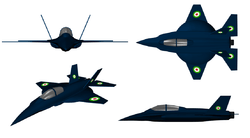HESA Shafaq
| Shafaq | |
|---|---|
 | |
| Role | Trainer / Attack aircraft |
| National origin | Iran |
| Manufacturer | Iran Aircraft Manufacturing Industrial Company (HESA) |
| Designer | Aviation University Complex |
| First flight | 2017 (forecast) |
| Status | Prototype |
| Primary user | Iran |
| Number built | One prototype |
| Developed from | M-ATF |
The HESA Shafaq or Shafagh (Persian: هواپیمای شفق, "Twilight" or "Aurora") is an Iranian subsonic stealth aircraft project being developed by the Iran Aircraft Manufacturing Industrial Company (HESA).[1]
Development
According to reports, the Shafaq will be a subsonic aircraft, but this might be changed. Additionally, Iranian Officials have reported that the Shafaq will have a skin of radar-absorbing material.[2]
This two-seat advanced training and attack aircraft appears to be based[3] on the Russian-Iranian "Project Integral" and are fitted with Russian ejection seats. Reportedly, there are plans to produce three versions—one two-seat trainer/light strike version and two one-seat fighter-bomber versions.[1]
The Shafaq is designed by the Aviation University Complex (AUC), part of the Malek-Ashtar University of Technology (MUT). At the start of the program, Iran received help from Russia[3] and the aircraft was known as Integral. Russia later backed away from this project for several reasons and Iran carried on the project by itself renaming it Shafaq. The Shafaq is designed as a sub-sonic aircraft,[3] and made of radar-absorbing material. It has a large leading edge root extension (LERX) and a root aft of the wing which gives it an unusual circular sub-section.[1]
A 1/7 scale model of the Shafaq has already completed testing in the AUC's wind tunnel and pictures have already been revealed which show that a full-scale model has already been built.[3] The Shafaq will be built in different configurations including a two-seater trainer, a two-seater light Attack and a one-seater light attack variants. Roll-out of the first prototype was scheduled for 2008.[2] The Shafaq's advanced cockpit features color MFDs and a Russian-made K-36D ejection seat.
According to AIO (Aerospace Industries Organisation), the aircraft that will be flight tested during 2017 and will have twin, outwardly canted vertical fins. This type of a tail design has become a favoured aerodynamic feature of Iranian designers that dates back to the development of the reverse-engineered Iranian version of the Northrop F-5, the HESA Saeqeh.[4]
Specifications
Data from Trend[5]
General characteristics
- Crew: one or two (Pilot and Radar Intercept Officer)
- Length: 10.84 m ()
- Wingspan: 10.45 m ()
- Height: 4.26 m ()
- Empty weight: 4361 kg ()
- Max. takeoff weight: 6900 kg ()
- Powerplant: 1 × Klimov RD-33 turbofan, 50.0 kN (11,230 lbf)
Performance
- Service ceiling: 16,780 m (55,040 ft)
- Rate of climb: 110 m/s (21,650 ft/min)
Armament
- Sattar, Shahbaz, Fatter missiles
See also
Related development
Aircraft of comparable role, configuration and era
Related lists
References
- 1 2 3 "Shafaq". globalsecurity.
- 1 2 . ainonline https://web.archive.org/web/20080226045858/http://www.ainonline.com/airshow-convention-news/dubai-air-show/single-publication-story/browse/0/article/iran-struggles-to-field-a-fighter/?no_cache=1&tx_ttnews%5Bmode%5D=1. Archived from the original on February 26, 2008. Missing or empty
|title=(help) - 1 2 3 4 Larkins Dsouza (September 22, 2007). "Shafaq- Iranian Stealth Plane". defenceaviation.
- ↑ "Iranian Shafaq jet trainer nears prototype testing | IHS Jane's 360". www.janes.com. Retrieved 2017-03-15.
- ↑ "Iran unveiled new indigenous fighter jet". Trend. 2 February 2013. Retrieved 4 March 2016.
External links
| Wikimedia Commons has media related to Shafagh. |
- GlobalSecurity.org: Shafaq (Before Dawn)
- ainonline.com: Iran struggles to field a fighter
- aeronautics.ru: aka "Vityaz-2000": a Russian based JSF